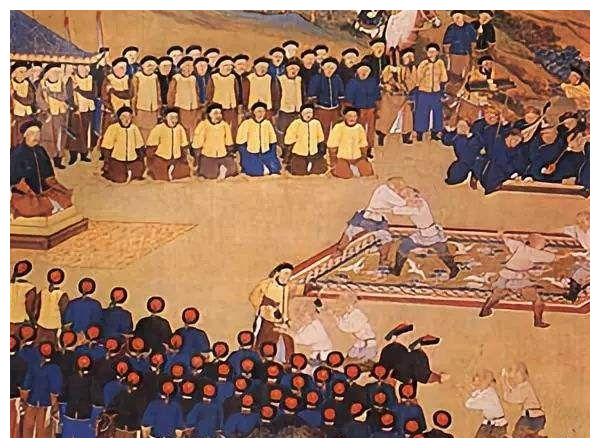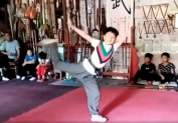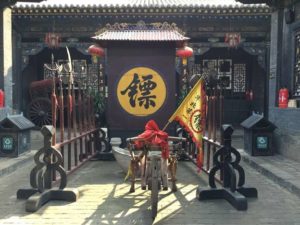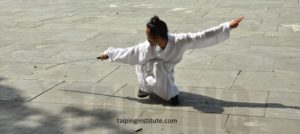Shan Pu Ying was established by Emperor Kangxi in 1669. Its origin is an interesting story, a significant event in the history of the Qing Dynasty. Kangxi was only 8 years old when he inherited the throne in 1661. During his father Emperor Shunzhi’s time, the Manchurians completed the conquest and control over all of China. Since Kangxi was still a boy, Shunzhi in his will named four high-level officials as advisors, giving them the power to govern until Kangxi came of age.
One of these officials was the famous general Aobai. Physically a very large and powerful man, because of the bravery and skill displayed during countless battles of his career, he was honored as “No. 1 Warrior of Manchuria”. Now, placed in this special position, he began to seize control for himself. In time he became the most powerful person in the country. Everyone feared and obeyed him. Such was his arrogance that he did not even bother showing respect to the young emperor. He would walk directly into the emperor’s office and use the emperor’s royal pen and special paper to write whatever order he wanted, and he would use the emperor’s name. When Kangxi was about 12 years old, Aobai wanted to kill several high-ranking government officials since they did not always obey him. At first the emperor refused, but General Aobai was able to intimidate the young emperor with threats of a beating him. Even though he feared Aobai, at this time Kangxi made the decision to kill him. This would be extremely difficult, as Aobai controlled everything, including the Emperor’s guard. There was no one around him at the time whom he could trust.
However Kangxi was one of the smartest emperors in Chinese history. In time he would go on to accomplish many great things, and he would reign for 60 years. Aobai was to be his first challenge. Shuai Jiao was very popular at that time, especially in the warrior culture of the Manchurians. Kangxi selected fifteen young boys from his royal family to practice Shuai Jiao with him everyday. They practiced openly in the yards of the Forbidden City, never trying to conceal any part of their practice. So no one suspected their true intentions.
People thought these were just boys being boys. At the same time, Kangxi displayed nothing but complete trust in Aobai, letting him control everything without protest. In Aobai’s mind Kangxi was no different from any other boy his age, that he only cared about playing and having fun. Three years passed like this, the emperor was fifteen now. All the while Aobai became more and more powerful. No one noticed that the emperor and his
Shuai Jiao fellows had become much stronger and developed particularly good skills.
On May 16, 1669, Aobai went to the emperor’s office by himself as usual. When he entered the room the door closed behind him. The emperor and his young Shuai Jiao fellows were in the room. The emperor asked Aobai, “Do you know that you are guilty of treason?” “I do not know!” Aobai defiantly replied. “Tie him up!” The emperor ordered his companies. When Aobai heard this order, he had a great laugh because he thought it was a joke. As the battle-proven No. 1 warrior of the nation, he thought he could easily beat all of these young guys.
The fighting is said to have been incredibly fierce: in the beginning Aobai beat several of the
boys badly. Then one of the boys set up a trip to throw him, and Aobai lost his balance.
Immediately the others jumped on him. He was finally held to the ground and tied up. Everyone in the government was shocked by the sudden capture of Aobai. Where everyone feared Aobai before, now they feared the young emperor who had subdued him. They immediately pledged support for the emperor. Aobai was thrown in jail, and the emperor restored to power.
After this, the emperor Kangxi established a new bodyguard camp called “Xiang Pu Ying” based on his Shuai Jiao companies. Then its name was changed to “Shan Pu Ying.” Shan Pu means good throwing or wrestling, and Ying means camp. In this camp everyone had to practice Shuai Jiao. The leader of Shan Pu Ying had to be a prince, either the emperor’s brother or son. The camp had two divisions and was stationed in separate locations in the eastern and the western parts of Beijing city, usually called the Eastern Camp and the Western Camp. Each camp was usually made up of around two hundred soldiers. Part of the highly selective admission test was a Shuai Jiao exam. Upon admission each would
receive a rank according to their skill level. There were four levels of rank, the first level being the highest. Everyone’s salary was tied to their rank. The pay was higher than most other jobs the average citizen could acquire.
Although Shan Pu Ying was part of the emperor’s security guards, they didn’t have many duties. So basically they were professional Shuai Jiao players who practiced full time. For this reason the Shan Pu Ying guard is sometimes regarded as the national Shuai Jiao team. There are a lot of evidences supporting this. For example, outside of their training, their most important job was to participate in the performances and competitions held several times a year for the emperor.
In the Chinese calendar, there were three big performances and competitions around the Chinese New Year: December 23, December 29, and January 29. On December 23, the wrestlers of Shan Pu Ying would perform Shuai Jiao for the emperor in Yangxin Dian palace, where the emperor’s main office was. Although it did not matter too much who won or lost at this event, everyone wanted to show off his beautiful skill in front of the emperor.
On December 29, just before Chinese New Year, the emperor would meet the officials from other kingdoms and outside groups in Yangxin Dian to receive their New Year gifts. According to tradition, some groups, like the Mongolians, could bring their wrestlers to perform Shuai Jiao and compete in front of the emperor. So the emperor would call on his wrestlers to perform and compete against the visitors. This was a hard time for the Shan Pu Ying wrestlers since they were the emperor’s team. They were obliged to win the competition. If they lost, then the emperor would lose face, and severe punishments were sure to follow. So year-round training was geared toward winning this event. During the competition there would be no holding back. Records tell us that on several occasions Shan Pu Ying masters killed visiting wrestlers with hard throwing techniques during the heat of these competitions.
Also every year, the East and West camps needed to compete two more times to validate their training and promote certain people. Joining the Shan Pu Ying didn’t guarantee that you could hold this job forever. If your performance was not good enough, you could be let go at any time. However, if you could perform well and received a high rank, when you got older, you could get transferred to another good job in the government until you retired.
From these events the competition rules were formalized and completed, and they are still in use today. Secondly, since the competition was so intense, it really pushed the development of the skills, as well as the training system, making them more detailed and refined. Another important factor that pushed the development of skill was the lack of any weight divisions. The smaller wrestlers had to have very good skills just to remain on the team. Also, in most competitions, the winner was decided by just one throw. Together, all of
these factors combined to drive the development of Shuai Jiao skills to a very high level. Such was the environment for about 250 years. In each of those years over 400 hundred of the best wrestlers in the country stayed together everyday, practicing and researching under incredible pressures and incentives. You can easily understand what the results would be.
Because of the unique nature of the Manchurian’s rule, it was during this period that the traditional Chinese Shuai Jiao skill merged with Mongolian and Manchurian Shuai Jiao skills, gradually forming a new system.




